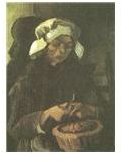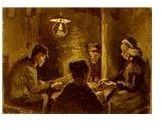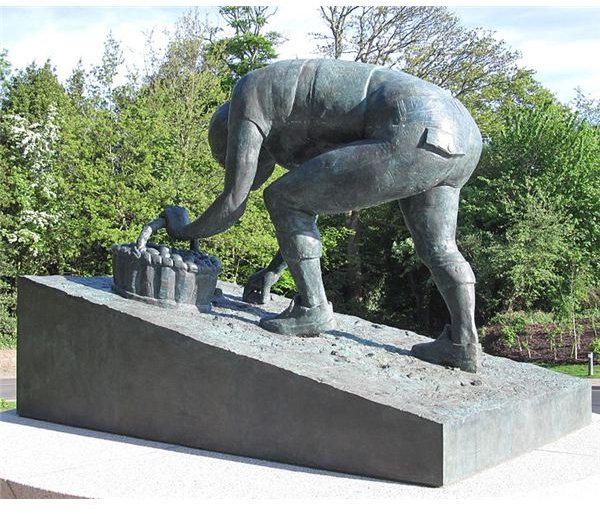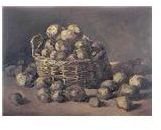The Continuing Art and History of the Potato
Ancient History
In the history of the potato, we find that this root vegetable was cultivated and worshiped by the Mayan and Inca cultures in Peru since
around 500 BCE. Six thousand years ago, for pre-Columbian tribes in the Andes, this tuber was a staple of their diet. However, for the highly developed and sophisticated Inca, the potato was not only food but also an object of cult and religion. Incas dried potatoes for burial with the dead as well as for travel, where they were eaten dry or softened in liquid. The Mayans were the first to honor the potato in art, creating sculptures and carvings.
Europe Discovers Spuds
The papas, as the Inca called them, did not arrive in Europe until the 16th century. In 1565, failing to find the expected abundance of

gold, the Spanish conquistador Gonzalo Jimenez de Quesada brought the potato back instead. However, the nutritional value of the papas was not immediately recognized.
Some Europeans considered the plant exotic due to the delicate star shape of the flowers. Fashionable women wore the flowers in their hair. Other Europeans, however, vilified the plant as evil. When the potato reached England, the leaves and stems were boiled, which are indeed poisonous parts. Later in France and Germany, the potato, when finally cooked and consumed in the correct way, was considered poor folk’s food and shunned by the wealthy. It was only during the last two centuries that this valuable tuber finally came into its own.
The Potato Famine of Ireland, a low point in the history of this much-maligned vegetable, decimated the population. Because it was a staple food for the poor, the blight of the potato left close to a million dead, with another million immigrating to the New World.
Cultural Identity
The potato is part of the identity of American and English culture - fish and chips, hamburgers and fries; mention either of these food

combinations and most people immediately identify the country of origin. Americans can thank Thomas Jefferson for bringing “potatoes served in the French manner” - pommes frites - into the culture.
Historians believe that the first potato plots within the U.S. were established in Londonderry, NH around 1872; however, today, several U.S. states harvest the nation’s potatoes. Idaho is the most recognized grower of potatoes, while Maine potatoes are a favorite among New Englanders.
Along with the popularity of the common spud, came a proliferation of American dishes associated with the potato such as mashed potatoes and gravy, home fries, hash browns and twice-baked potatoes. Some might say that the lowly potato is the staple of the American diet.
The Artist’s View
The humble state of the potato, as well as those who ate it, were immortalized in the art of Vincent Van Gogh’s in The Potato Eaters,

Four Seasons: Potato Harvest and Basket of Potatoes, among others. Other artists such as Philip Sadee honored the peasant with paintings such as The Potato Gleaners. French filmmaker, Agnes Varda produced a documentary, The Gleaners and I, in which she describes the plight of modern gleaners as well as her obsession with heart-shaped potatoes. (Gleaners are people who go into the fields at the end of the harvest to gather what has been left behind by the farmer. In France, the law states that farmers must allow gleaners into the field.)
The Potato Museum in–you guessed it, Idaho–provides a diverse selection of art, artifacts and information on the potato. The museum’s website offers teacher and student resources as well as online exhibits from fine art to agricultural posters. The Potato Museum’s mission is to educate the world about the potato.
If traveling in Munich, the Kartoffelmuseum is a privately owned museum dedicated to potato art and history.
And if you’re still wondering about that vice president, it was Dan Quayle who, in 1992, prompted a 12-year-old student at an elementary school in New Jersey to spell potato with an “e” on the end. He later claimed that the word was spelled that way on a flash card provided by the school. Who knows?
References
- U.S Potato Board: History of Potatoes.
- Image: The Harvest/By Man vyi (own photo)/Public domain/Wikicommons
- In the Know Traveler: Potato Sculpture in Munich.
- Potato Museum: Welcome.
- What’s Cooking America.net: History of Potatoes, Linda Stradley.
- Image: Basket of Potatoes/Public Domain/Wikicommons
- Image: Peasant Woman Peeling Potatoes/Public Domain/Wikicommons
- Idaho Potato Museum: Welcome.
- Image: Potato Eaters/Public Domain/Wikicommons
